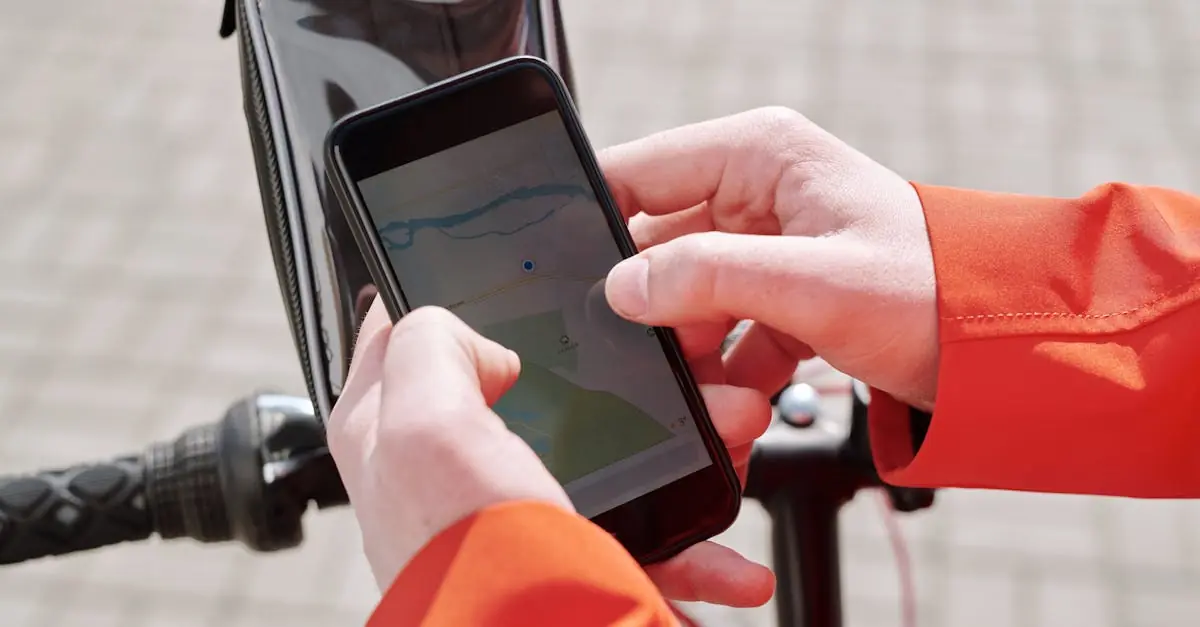Cycling enthusiasts know the thrill of hitting the open road, but finding the perfect route can sometimes feel like searching for a needle in a haystack. Enter cycling route apps, the trusty sidekick every cyclist didn’t know they needed. These digital navigators not only help avoid those dreaded wrong turns but also uncover hidden gems in the great outdoors.
Table of Contents
ToggleOverview of Cycling Route Apps
Cycling route apps streamline route planning by offering tailored suggestions based on individual preferences. These applications help cyclists locate safe and scenic paths, catering to various skill levels and types of bikes. By utilizing GPS technology, users can access real-time navigation, making it easier to explore new areas without losing their way.
Popular cycling route apps include Strava, Komoot, and MapMyRide. Strava excels in tracking performance metrics, providing insights into speed and distance. Komoot stands out with its detailed offline maps, ensuring access even in remote locations. MapMyRide offers a robust community feature, enabling cyclists to share routes and tips.
Features of these apps often include elevation profiles, route difficulty ratings, and user-generated content. Elevation profiles assist in evaluating the challenges of a route before cycling. Route difficulty ratings help cyclists select paths that align with their skills and preferences. User-generated content fosters a sense of community by allowing cyclists to contribute their experiences.
Compatibility with wearables enhances the functionality of cycling route apps. Cyclists can sync their data with smartwatches or fitness trackers, receiving notifications and metrics during rides. This integration improves overall performance tracking and motivation.
Safety is a significant aspect of cycling. Many apps offer alerts for hazardous road conditions or traffic, ensuring cyclists stay informed while riding. Some apps also feature route sharing, allowing friends or family to monitor a cyclist’s progress.
Cycling route apps significantly enhance the cycling experience, whether for casual riders or serious enthusiasts. Their ability to provide reliable information and foster community makes them indispensable tools for modern cyclists.
Key Features to Look For
Cycling route apps offer numerous features that enhance the riding experience. Selecting the right app means focusing on specific functionalities.
User-Friendly Interface
An intuitive design simplifies route finding and navigation. Users appreciate clear menus and easy access to essential tools. Large buttons and touch-responsive layouts improve usability, especially while cycling. Features allowing for quick zoom-in and zoom-out on maps enhance visibility. Clear icons help users identify important information at a glance. A customized dashboard displays relevant preferences, making the app feel personal and accessible.
Navigation Accuracy
Accurate navigation ensures cyclists follow the best paths without confusion. Real-time GPS tracking provides precise positioning even in dense urban areas. Features like turn-by-turn directions minimize errors during rides. Route recalculation adjusts paths instantly when cyclists stray. Advanced mapping technology showcases elevation changes, helping users prepare for challenging segments. Regular updates keep the map database current, providing reliable routes.
Community and Social Features
Connecting with fellow cyclists enhances the overall experience. Community-driven routes allow users to share personal favorites and tips. Social features, like leaderboards and ride challenges, foster friendly competition and motivation. Users can send messages and coordinate group rides within the app. Accessing user-generated content offers valuable insights into local paths and hidden gems. Sharing achievements on social media can inspire others to cycle, strengthening the community bond.
Popular Cycling Route Apps Reviewed
Cycling route apps greatly enhance the experience of cyclists by offering important features for navigation and route planning. Here are three popular apps evaluated for their performance and features.
App 1: Strava
Strava stands out for its comprehensive performance tracking. It delivers in-depth metrics, including speed, distance, and elevation gain. Users appreciate the segment competition feature, allowing cyclists to challenge their personal bests. Activity sharing fosters community engagement, creating a social environment to connect with others. Mobile and web versions ensure accessibility, with a user-friendly interface that simplifies navigation.
App 2: Komoot
Komoot excels in providing detailed offline maps. This feature allows cyclists to access maps without mobile data, ensuring cyclists remain oriented in remote areas. Users can plan multi-day trips with varied terrain profiles, catering to different skill levels. A trip planning tool suggests scenic routes based on user preferences, enhancing exploration. Voice navigation keeps hands free, ensuring safety while riding.
App 3: MapMyRide
MapMyRide focuses on community and interaction. Features include route sharing and user-generated content, allowing cyclists to discover popular local paths. Detailed metrics track performance similar to other apps, such as calories burned and ride duration. Customizable workouts offer tailored training options for cyclists of any level. An extensive library aids in discovering routes and connecting with fellow cyclists.
Benefits of Using Cycling Route Apps
Cycling route apps offer numerous benefits that enhance the overall experience for cyclists. They simplify route planning, helping users discover safe paths tailored to personal preferences. Utilizing real-time GPS technology, these apps assist in navigating unfamiliar areas, reducing the likelihood of getting lost.
Safety features in these apps contribute significantly to a secure riding experience. Alerts for hazardous conditions keep cyclists informed about road risks, such as construction or poor weather. Furthermore, route sharing capabilities enable users to exchange information on the best paths, fostering a sense of community among riders.
Scenic routes often remain undiscovered without the help of cycling route apps. Many apps include user-generated content, which showcases hidden gems and picturesque landscapes. Elevation profiles and route difficulty ratings are also crucial, allowing cyclists to assess their options based on skill level and physical ability.
Compatibility with wearables enhances the functionality of these applications. Cyclists can track performance metrics in tandem with navigation, leading to better overall results and more rewarding rides. Regular participation in community features encourages interaction and competition, motivating cyclists to improve their skills.
Exploring new terrains becomes easier when cyclists can access detailed offline maps. This feature proves essential in areas with limited internet connectivity, ensuring riders always have the information they need at their fingertips.
Enjoying a seamless user experience is important for maintaining motivation while cycling. User-friendly interfaces in these apps enable easy navigation through complex menus and layouts. Prioritizing accurate navigation with turn-by-turn directions allows cyclists to focus on the road ahead without distractions.
Utilizing cycling route apps ultimately transforms the journey into a more enjoyable and engaging experience. They serve as indispensable tools for cyclists, regardless of experience level, enhancing every ride with tailored support and valuable insights.
Cycling route apps have revolutionized the way cyclists explore their surroundings. With features designed to enhance navigation and safety these tools cater to riders of all skill levels. By offering personalized route suggestions and real-time updates they empower cyclists to discover new paths and connect with fellow enthusiasts.
The integration of community features fosters a sense of belonging while performance tracking helps riders improve their skills. As technology continues to advance these apps will only become more essential for anyone looking to elevate their cycling experience. Embracing these tools can lead to more enjoyable and fulfilling rides.





